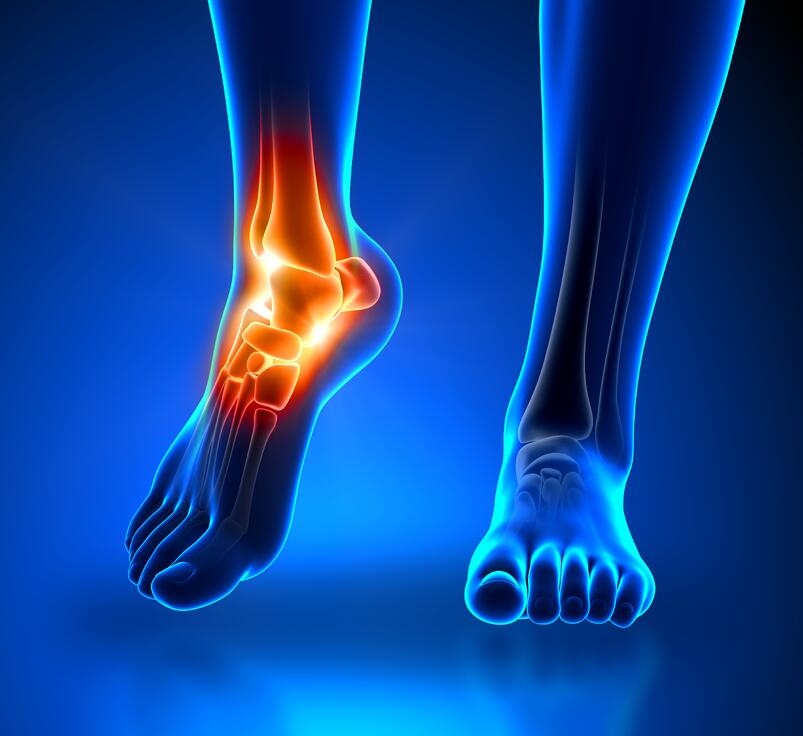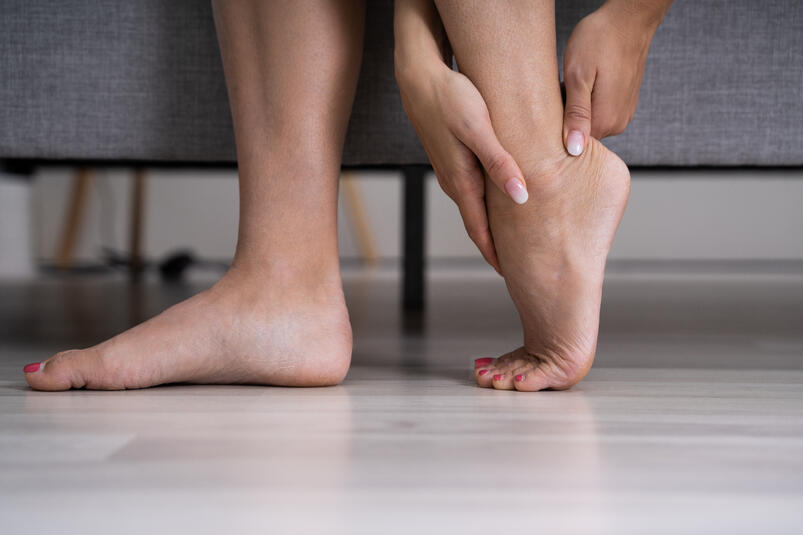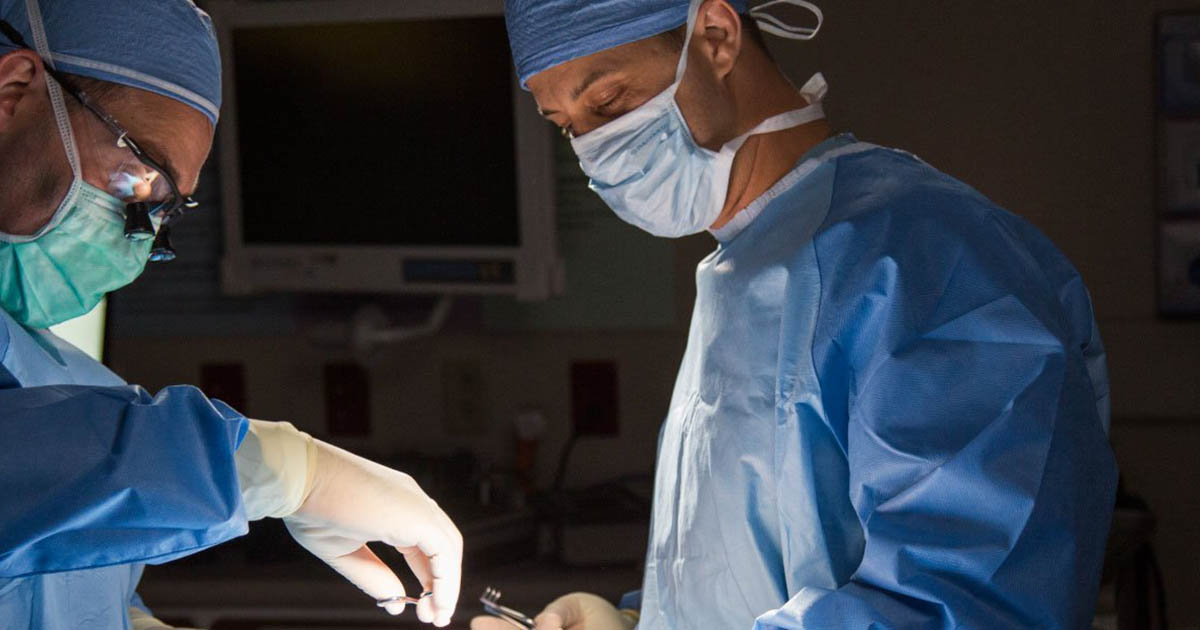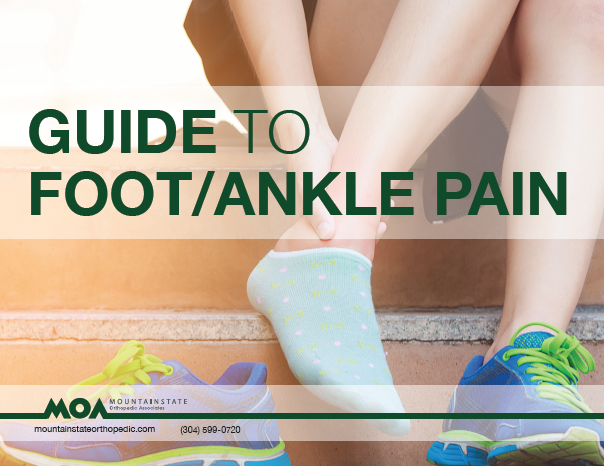
Foot & Ankle Care
Get Relief from Foot & Ankle Pain
As the foot and ankle are so complex, there are numerous conditions that can cause pain or agitation. At Mountainstate Orthopedic Associates, the most common issues we see relate to tendinitis, breaks and fractures, sprains, arthritis and plantar fasciitis.
Fill out the form below to download our free Guide to Foot/Ankle Pain and learn about these common issues. Contact our office to schedule an appointment.
Table of Contents
About the Foot & Ankle
The foot and ankle are often considered as separate parts of the body, although they genuinely work as a connected unit. That’s why foot pain can often lead to ankle problems and vice versa.
When you experience foot or ankle pain, the pain may be in your toes or even in the back of your heel along your Achilles tendon. As the bones, ligaments, tendons and muscles in the foot and ankle are so involved, problems shouldn’t be ignored. Your foot and ankle carry your entire body weight, making them susceptible to injury and pain.
It’s essential to see a doctor for foot and ankle issues. Ignoring even mild to moderate pain could lead to a more severe problem that may limit your mobility.
Conditions & Symptoms
As the foot and ankle are so intricate (the foot has 26 bones and more than 30 joints!), numerous conditions can cause pain or agitation. At Mountainstate Orthopedic Associates (MOA), the most common issues we see relate to tendinitis, breaks and fractures, sprains, arthritis and plantar fasciitis.
Tendinitis
In the foot and ankle, the most common type of tendinitis we see is Achilles Tendinitis, an overuse injury of the Achilles tendon. The Achilles tendon connects the calf muscles to the heel bone. It’s a common injury in people who have recently started an exercise routine, those who play sports like tennis or basketball where there is lots of running and jumping and runners of all levels. Additionally, the tendon weakens with age, making it more common in middle-aged people, especially those who are inconsistently active — for example, those who only play sports on the weekends.
Fortunately, Achilles Tendinitis is much less severe than a tear in the Achilles tendon. It can often be treated with at-home care, but you need to see a doctor to ensure that it is indeed tendinitis and not a more severe injury. If left untreated, or if activity continues despite the tendinitis, the injury can lead to tendon tears that require surgery to heal correctly.
The pain people typically feel with Achilles Tendinitis is a mild ache in the back of the leg or above the heel. The pain is usually worse after physical activity and also when waking up or after long periods of inactivity.
Treatment may include rest, immobilization, medications, or physical therapy. Severe and chronic cases may require surgery to clean or repair the tendon.
BREAKS AND FRACTURES
Many things can cause a broken foot or ankle, but it’s usually the result of an accident, whether a fall or a car accident. Some fractures are relatively minor and will heal alone in time; however, some breaks can be severe and even pierce the skin.
Stress fractures are different — they’re not typically caused by an accident. They occur over time and are caused by constant force and overuse. They’re common in track and field athletes, but anyone can get them. We often see them in patients who have recently started a new exercise regime and did too much, too soon.
Breaks and fractures typically present themselves with throbbing pain, swelling and bruising, tenderness, difficulty bearing weight or walking and sometimes deformity.
Treatment for a fracture or break depends on the severity of the injury. Some fractures will heal with a single boot or cast to minimize movement in the injured area. Some severe breaks may need surgery with implant plates, rods, or screws to ensure that the bone heals correctly.

SPRAINS AND INSTABILITY
Sprains are often categorized with broken bones; however, they’re different as they affect the ligaments, not bones. Sprains are common, especially in the ankle — they happen when you twist, roll or turn your ankle in a way that stretches or tears the ligaments. The ligaments are durable bands of tissue that help hold the bones in your ankle together.
The ligaments provide stabilization to your joints. When the joint moves beyond its normal range of motion, a sprain can occur. If you’ve sprained your ankle, you may experience pain when you try to put weight on your foot, swelling and/or a limited range of motion.
Sometimes a sprain will go away by merely limiting activity and “taking it easy.” However, we always recommend seeing a doctor ensure that it is indeed a sprain and not a fracture or break. Severe sprains can take weeks to improve and may need a boot or a cast. Acute sprains rarely require surgery.
Repeated ankle sprains can cause some patients to develop chronic ankle instability, a debilitating condition that causes persistent pain. Ankle instability can also cause the joint to “give way.” If untreated, it can lead to chronic pain and arthritis.
Physical therapy can help chronic instability, but often a procedure to repair or reconstruct the ligament is necessary.

Arthritis
Arthritis is a condition that affects a joint’s ability to work usually. It’s common in older adults (60s and 70s), but can occur in younger people, too. There are many types of arthritis; the most common is osteoarthritis, which occurs as a result of “wear and tear.” As we age, the cartilage around our joints wears down. The damage can cause swelling, pain, redness, and inflammation.
We also see many patients who have rheumatoid arthritis, which is caused by irritation of the synovium (joint lining). Rheumatoid arthritis is an autoimmune disease, meaning it is caused by the body attacking the joint linings. There’s no cure for it, but at MOA, we’re able to help people find comfort and continue to live active lives through physical therapy and medication.
Other less common forms of arthritis include gout, reactive arthritis, psoriatic arthritis and infectious arthritis.
At MOA, we treat all aspects of arthritis. You can’t just treat the pain if the arthritis is causing a deformity in the joints. We start by confirming the type of arthritis you have and then put together a plan of treatment designed to allow you to live a more comfortable and active life.
One of the most common surgeries for severe ankle arthritis, whether it be osteoarthritis, rheumatoid arthritis, or arthritis caused by a previous injury to the joint, is ankle fusion. Ankle fusion, also called ankle arthrodesis, is a surgery to fuse the bones in the ankle into one piece.
The ankle fusion surgery will fuse two or more bones in the ankle to help stop the pain and swelling. The bones are compressed and attached with hardware such as plates, nails, or screws. In some cases, a bone graft may also be used — this will help the two bones heal together. The goal of the surgery is to eliminate the daily pain caused by arthritis. A similar surgery can be performed for arthritis of the small bones of the foot and even the toes.
Treatment options include medications, steroidal injections, physical therapy, special shoe inserts (orthotics) and, if applicable, weight loss. While surgery can help some cases of arthritis, we consider it a last resort and are always conservative with our course of treatment. This means we will never recommend surgery without trying physical therapy and/or medication first.
Plantar Fasciitis
Sprains are often categorized with broken bones; however, they’re different as they affect the ligaments, not bones. Sprains are common, especially in the ankle — they happen when you twist, roll or turn your ankle in a way that stretches or tears the ligaments. The ligaments are durable bands of tissue that help hold the bones in your ankle together.
The ligaments provide stabilization to your joints. When the joint moves beyond its normal range of motion, a sprain can occur. If you’ve sprained your ankle, you may experience pain when you try to put weight on your foot, swelling and/or a limited range of motion.
Sometimes a sprain will go away by merely limiting activity and “taking it easy.” However, we always recommend seeing a doctor ensure that it is indeed a sprain and not a fracture or break. Severe sprains can take weeks to improve and may need a boot or a cast. Acute sprains rarely require surgery.
Repeated ankle sprains can cause some patients to develop chronic ankle instability, a debilitating condition that causes persistent pain. Ankle instability can also cause the joint to “give way.” If untreated, it can lead to chronic pain and arthritis.
Physical therapy can help chronic instability, but often a procedure to repair or reconstruct the ligament is necessary.
Special shoe inserts called orthotics may also help by relieving pressure. Night splints that stretch the arch of the foot and calf while you’re sleeping hold the Achilles tendon and the plantar fascia in an elongated position to help stretch them. Surgery is rarely needed to treat plantar fasciitis; however, it does have a good outcome for those who need it.

BUNIONS
A bunion is a bony bump that developed on the joint at the base of the big toe. It occurs when your big toe pushes against the next toe, which forces the joint to get bigger and protrude. The skin is often sore and red. Smaller bunions, called bunionettes, are often seen on the joint of the little toe.
As the bunion rubs up against shoes, it may aggravate it, making it more tender and inflamed. They may develop as a result of an inherited issue with the foot or due to a medical problem like rheumatoid arthritis. Wearing high heels or shoes that are too tight can also make you more susceptible to bunions.
Bunions and bunionettes don’t always require medical treatment; however, if you’re experiencing persistent pain, have a visible bump, discomfort wearing or finding shoes or a decrease in the range of motion in your big toe or foot — you should see a doctor.
Your doctor will suggest more conservative treatments such as new shoes, padding and/or splinting medications, and shoe inserts. Rarely, a bunion would ever need surgery, unless it’s severely impacting your daily activities and causing extreme pain.
CLAW TOE
At MOA, we take great pride in the reputation and ability of our surgical staff. We will always try more conservative treatment options before recommending surgery for any foot or ankle problems.
Even when surgery is required, our patient’s recover well. And while we readily admit that you may never feel quite like you did before the injury, the goal is to be able to return to an active and happy life. Sometimes modifications to activity are needed and sometimes continued physical therapy is recommended — but our primary goal is accomplished: eliminating the pain.
SURGERY AT MOUNTAINSTATE ORTHOPEDIC ASSOCIATES
Claw toe is a common foot deformity, which is often the result of nerve damage caused by alcoholism or diabetes. Both alcoholism and diabetes can weaken the muscles in your foot. Having claw toes means that the toes dig into the soles of your shoes, which results in painful calluses. If left untreated, it may become a permanent deformity.
You must see a doctor if you begin to notice symptoms of claw toe: the toes bend upward from where they join to the foot but bend downward from the middle toe joint. In some cases, toes may curl under the foot, in addition to corns developing on either the top of your toe or ball of your foot.
If the claw toe deformities are still flexible, your doctor may splint or tape the toes into their correct position. If the claw toe is in the later stages, your doctor will discuss your options with you, which may involve surgery to straighten and pin the toes in place.

PREVENTION
Unfortunately, accidents happen, making it impossible to prevent all foot and ankle injuries. Although being intelligent about the progression of exercise and gradually increasing the intensity of the activity will help reduce the risk of exercise-related foot and ankle injuries.
There are hereditary components to some foot and ankle problems, namely arthritis-related issues. Some sports have a higher incidence of specific injuries; for example, Achilles tendon tears are more common in sports where there is a high impact on the ankle, such as basketball.
Correctly warming up with a combination of dynamic and static stretching, wearing appropriate quality footwear, and following directions from your physical therapist or doctor will go a long way in preventing severe foot or ankle injuries.
HOW WE CAN HELP
MOA is one of the region’s leading orthopedic practices. We take pride in the education and experience that each of our doctors holds.
From your initial appointment to the conclusion of your treatment, we strive to keep you informed and active in the decision-making process. It’s always our policy to be conservative with our course of treatment, only recommending surgery if it is genuinely needed.
We also seek to be minimally invasive in our treatments, reducing the amount of time a patient is in the hospital. With many of our surgical procedures, patients are home the same day of surgery.

SOURCES
Mayo Clinic
mayoclinic.org
American Orthopaedic Foot & Ankle Society
aofas.org
Johns Hopkins Medicine
hopkinsmedicine.org
Get back to everyday tasks!
In our “Foot/Ankle Pain Guide,” you will learn about:
- causes of foot and ankle pain
- symptoms
- treatment
"*" indicates required fields

